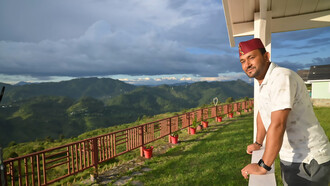“That temper of yours is a dangerous thing.”
(Ned Stark, Game of Thrones)
Ned Stark cuddles amorously to his wife Catelyn with this unforgettable line in their goodbye scene from the blockbuster series Game of Thrones. If you haven’t been dragooned (pun unintended) to follow the miniseries that continues to keep audiences worldwide tingling in fright and suspense, perhaps, now you will be after discovering the epic drama’s film locations set around the antiquated and breathtaking island of Malta. In this particularly moving scene, the couple exchange farewell notes of sweet nothings in front of Mdina’s city gate, a massive fortification in Baroque style standing over an arched stone bridge decorated with lion statues.
Mdina, also referred to as ‘Città Vecchia’ (Old City) or ‘Città Notabile’ (Notable City), continues to shine as one of Europe’s most elegant walled cities for over 4000 years. Tucked in the west-central region of Malta, a tiny archipelago beneath Sicily, Italy, rich in Norman, Baroque and English classical limestone architecture, and surrounded by the exquisite inner harbor and sparkling blue Mediterranean Sea, the former capital till the Medieval period has stolen the hearts of many photographers, artists, writers and filmmakers.
From the current capital Valletta to the northern tip island of Gozo, we may remember scenes from many of James Bond films Casino Royale, The Spy Who Loved Me, For Your Eyes Only, and Never Say Never Again. One of the most memorable movies filmed on the Vittoriosa waterfront was The Count of Monte Cristo. At Fort St Elmo, home of the Malta police academy, Brad Davis is imprisoned in award-winner Oliver Stone’s screen adaptation of Midnight Express. Even director Ridley Scott tricked Roman fans into using Fort Ricasoli in Kalkara for the Roman sets of the Gladiator. Brad Pitt’s Achilles challenges Patroclus to a swordfight while Sean Bean’s Odysseus arrives at the temple ruins built on the cliffside of Mellieha from Troy. The list goes on to Zeppelin, When Eight Bells Toll, Murphy’s War, The Golden Voyage of Sinbad, Raise the Titanic, Alexander, Conan the Barbarian and even the delightful Popeye.
However, it is in the enchanting Silent City, Mdina, where many memories of movie legends are best captured: Roman Polanski’s Pirates; Swept Away; Black Eagle; Trenchcoat; the classic The Count of Monte Cristo; and recently, the King’s Landing façade, Baelish’s brothel balcony, the Jamie Lannister and Ned Stark swordfight at Mesquita Square, Coppersmith’s Wynd Cobbler's Square, and Tobho Mott's blacksmiths yard among other notable scenes in the megahit Game of Thrones.
The revered Italian painter Caravaggio chose Malta as his refuge after fleeing a murder in Rome only, by dark rumors, to be assassinated by the Knights of Malta. Romantic poets Samuel Taylor Coleridge, William Wordsworth, John Keats and William Blake all seized inspirations from Malta for their writings.
Hence, what magic potion does Malta diffuse enough to allure the minds and spirits of artists, writers and filmmakers? Centering on Mdina, start your journey from the formidable Baroque masterpiece Mdina Gate or the Vilhena Gate built in 1724, adorned with statues of patron saint St. Agatha, St. Paul and St. Publius, former Governor of the island. The entrance then opens to a labyrinth of stone-walled alleys, glittering in bright yellow-ochre sandstone, so captivating you feel immersed in the shadows of courageous knights training in sword fighting and archery, armored guardsmen protecting the mansions of the noble families, and plasterers, butchers, carpenters, coppersmiths and blacksmiths laboring under the siege of deadly heat.
Stroll around the four imposing medieval palaces: Palazzo Falson or Norman House built in 1495, depicting the two-light window design eminent of Maltese architecture; Palazzo Gatto Murina also built in the first half of the 15th century and embellished with floral and geometrical motifs and the famous Gatto Murina windows reminiscent of the old Sicilian style; Palazzo Inguanez belonging to the oldest noble family of Malta and originally built in 1370; and the Palazzo Santa Sofia, said to be the oldest edifice in Mdina, with moldings from 1233 and a picturesque courtyard.
The views from the Bastion dating from 1739 are equally exhilarating. Overlooking the vast countryside and pathway where pedestrians used to pass to enter the walled city, one can only hear a dead silence—absolute absence of cars or any other mode of transportation, a population of merely over 300 residents, and the haunted whispers of the forgotten city after the Great Siege of the Turkish and the transition from French to English domination that consequently gave its pen name the “Silent City.”
All that is the magic potion that spellbinds any explorer to this ancient castle land.
Only since its revival in the 18th century has the medieval city learned to enjoy vast reconstruction of its art, architecture and livelihood of the people. In decades to come, the influx of visitors yielded much admiration and appreciation of the sheer antiquity and grandeur of Mdina, which at present, remains to be one of the most photogenic and bewitching thrones in the Mediterranean.
“Never forget what you are, for surely the world will not. Make it your strength. Then it can never be your weakness. Armor yourself in it, and it will never be used to hurt you.”
(Tyrion Lannister, Game of Thrones)















